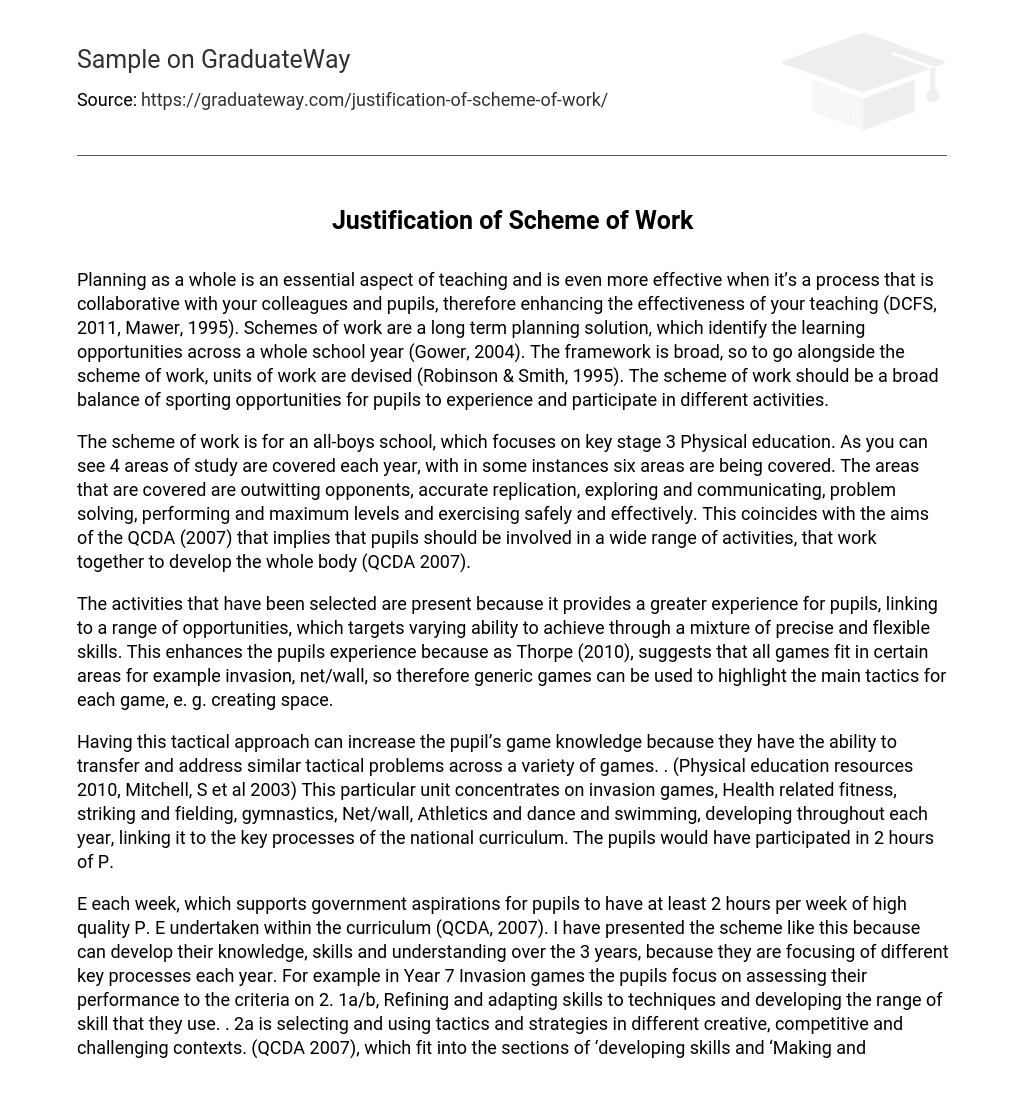Planning as a whole is an essential aspect of teaching and is even more effective when it’s a process that is collaborative with your colleagues and pupils, therefore enhancing the effectiveness of your teaching (DCFS, 2011, Mawer, 1995). Schemes of work are a long term planning solution, which identify the learning opportunities across a whole school year (Gower, 2004). The framework is broad, so to go alongside the scheme of work, units of work are devised (Robinson & Smith, 1995). The scheme of work should be a broad balance of sporting opportunities for pupils to experience and participate in different activities.
The scheme of work is for an all-boys school, which focuses on key stage 3 Physical education. As you can see 4 areas of study are covered each year, with in some instances six areas are being covered. The areas that are covered are outwitting opponents, accurate replication, exploring and communicating, problem solving, performing and maximum levels and exercising safely and effectively. This coincides with the aims of the QCDA (2007) that implies that pupils should be involved in a wide range of activities, that work together to develop the whole body (QCDA 2007).
The activities that have been selected are present because it provides a greater experience for pupils, linking to a range of opportunities, which targets varying ability to achieve through a mixture of precise and flexible skills. This enhances the pupils experience because as Thorpe (2010), suggests that all games fit in certain areas for example invasion, net/wall, so therefore generic games can be used to highlight the main tactics for each game, e. g. creating space.
Having this tactical approach can increase the pupil’s game knowledge because they have the ability to transfer and address similar tactical problems across a variety of games. . (Physical education resources 2010, Mitchell, S et al 2003) This particular unit concentrates on invasion games, Health related fitness, striking and fielding, gymnastics, Net/wall, Athletics and dance and swimming, developing throughout each year, linking it to the key processes of the national curriculum. The pupils would have participated in 2 hours of P.
E each week, which supports government aspirations for pupils to have at least 2 hours per week of high quality P. E undertaken within the curriculum (QCDA, 2007). I have presented the scheme like this because can develop their knowledge, skills and understanding over the 3 years, because they are focusing of different key processes each year. For example in Year 7 Invasion games the pupils focus on assessing their performance to the criteria on 2. 1a/b, Refining and adapting skills to techniques and developing the range of skill that they use. . 2a is selecting and using tactics and strategies in different creative, competitive and challenging contexts. (QCDA 2007), which fit into the sections of ‘developing skills and ‘Making and applying decisions, which is just undertaking the skills, refining it slightly to improve, linking this with acquiring tactical awareness. (QCDA 2007) If we move onto year 8 and 9, the key processes that are focused on are ‘evaluating and improving.
’ For example in Year 8 invasion games the pupils focus on 2. c, which is developing the precision, control and fluency of their skills (QCDA, 2007), which is a development on from year 7, so promotes progression. Progression is important throughout each year of the scheme, so this has to be planned and thought out so that the key processes are being met each year. (Raymond, 1998) Furthermore 2. 2B and C and undertaken because it makes pupils think about refining and adapting their ideas and plans to respond to changing environments, planning what needs to be practiced to be better in performance. QCDA, 2007) The Invasion games unit in year 7 will focus on tactical generic games to underpin to the main tactics for invasion games. This allows the pupils to transfer their learnt skills across a number of activities, this aids with their development to perform and accomplish problem solving activities. The tactical teaching approach is important for the development of tactical knowledge, which fits nicely into the key process 2. 2a, selecting and using tactics in challenging contexts.
This tactical knowledge is acquired to solve the decision making and skill execution problems that can occur within invasion game situations. (Hardy, 1999). Swimming and rookie lifeguard training units are included in year 8 and 9, to make use of all the facilities that are on offer, widening the variety of activities further for the pupils. The rookie lifeguard unit for year 9 is a progression from the stroke improvement because they will learn different aspects on water safety.
Striking and fielding activities go alongside the track and field events of athletics because the two summer complement each other, because they can be transferred to several facilities, which is very beneficial to planning a scheme of work. When it comes to accurate replication, this is addressed throughout the scheme. Trampolining was a progression from year 7 to 8 and 9, because this enhances variation and breadth throughout the scheme, keeping a varied approach to the activities available.





